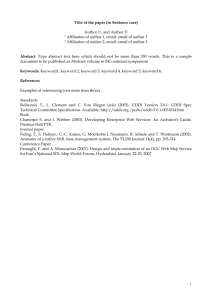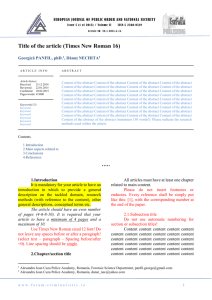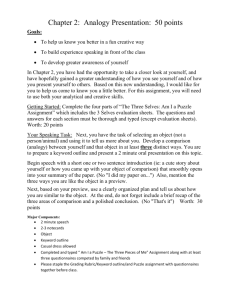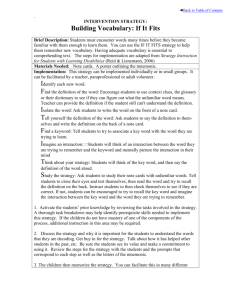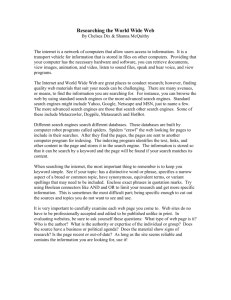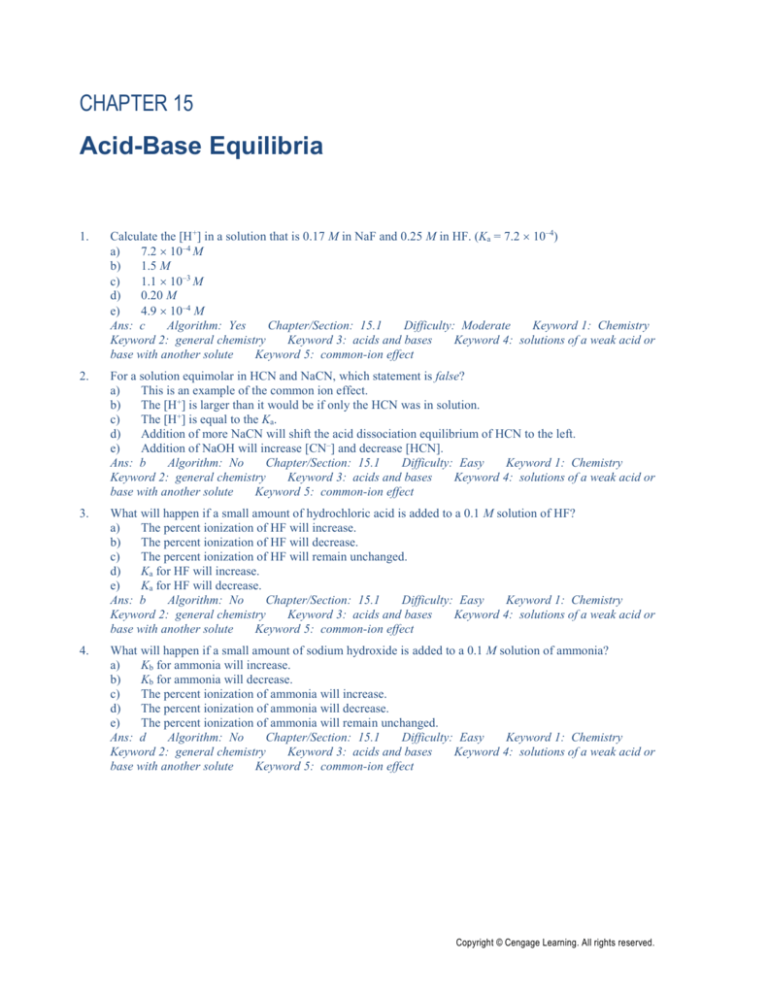
CHAPTER 15
Acid-Base Equilibria
1.
Calculate the [H+] in a solution that is 0.17 M in NaF and 0.25 M in HF. (Ka = 7.2 10–4)
a)
7.2 10–4 M
b)
1.5 M
c)
1.1 10–3 M
d)
0.20 M
e)
4.9 10–4 M
Ans: c
Algorithm: Yes
Chapter/Section: 15.1
Difficulty: Moderate
Keyword 1: Chemistry
Keyword 2: general chemistry
Keyword 3: acids and bases
Keyword 4: solutions of a weak acid or
base with another solute
Keyword 5: common-ion effect
2.
For a solution equimolar in HCN and NaCN, which statement is false?
a)
This is an example of the common ion effect.
b)
The [H+] is larger than it would be if only the HCN was in solution.
c)
The [H+] is equal to the Ka.
d)
Addition of more NaCN will shift the acid dissociation equilibrium of HCN to the left.
e)
Addition of NaOH will increase [CN–] and decrease [HCN].
Ans: b
Algorithm: No
Chapter/Section: 15.1
Difficulty: Easy
Keyword 1: Chemistry
Keyword 2: general chemistry
Keyword 3: acids and bases
Keyword 4: solutions of a weak acid or
base with another solute
Keyword 5: common-ion effect
3.
What will happen if a small amount of hydrochloric acid is added to a 0.1 M solution of HF?
a)
The percent ionization of HF will increase.
b)
The percent ionization of HF will decrease.
c)
The percent ionization of HF will remain unchanged.
d)
Ka for HF will increase.
e)
Ka for HF will decrease.
Ans: b
Algorithm: No
Chapter/Section: 15.1
Difficulty: Easy
Keyword 1: Chemistry
Keyword 2: general chemistry
Keyword 3: acids and bases
Keyword 4: solutions of a weak acid or
base with another solute
Keyword 5: common-ion effect
4.
What will happen if a small amount of sodium hydroxide is added to a 0.1 M solution of ammonia?
a)
Kb for ammonia will increase.
b)
Kb for ammonia will decrease.
c)
The percent ionization of ammonia will increase.
d)
The percent ionization of ammonia will decrease.
e)
The percent ionization of ammonia will remain unchanged.
Ans: d
Algorithm: No
Chapter/Section: 15.1
Difficulty: Easy
Keyword 1: Chemistry
Keyword 2: general chemistry
Keyword 3: acids and bases
Keyword 4: solutions of a weak acid or
base with another solute
Keyword 5: common-ion effect
Copyright © Cengage Learning. All rights reserved.
Chapter 15: Acid-Base Equilibria
383
5.
15.0 mL of 0.50 M HCl is added to a 100.-mL sample of 0.462 M HNO2 (Ka for HNO2 = 4.0 10–4). What
is the equilibrium concentration of NO2– ions?
a)
2.5 10–3 M
b)
1.6 10–4 M
c)
4.0 10–1 M
d)
5.0 10–2 M
e)
none of these
Ans: a
Algorithm: Yes
Chapter/Section: 15.1
Difficulty: Moderate
Keyword 1: Chemistry
Keyword 2: general chemistry
Keyword 3: acids and bases
Keyword 4: solutions of a weak acid or
base with another solute
Keyword 5: common-ion effect
6.
15.0 mL of 0.50 M NaOH is added to a 100.-mL sample of 0.442 M NH3 (Kb for NH3 = 1.8 10–5). What is
the equilibrium concentration of NH4+ ions?
a)
1.0 10–2 M
b)
6.9 10–6 M
c)
3.8 10–1 M
d)
1.1 10–4 M
e)
none of these
Ans: d
Algorithm: Yes
Chapter/Section: 15.1
Difficulty: Moderate
Keyword 1: Chemistry
Keyword 2: general chemistry
Keyword 3: acids and bases
Keyword 4: solutions of a weak acid or
base with another solute
Keyword 5: common-ion effect
7.
What is the percent dissociation of HNO2 when 0.074 g of sodium nitrite is added to 115.0 mL of a 0.068 M
HNO2 solution? Ka for HNO2 is 4.0 × 10–4.
a)
16%
b)
0.29%
c)
4.3%
d)
0.062%
e)
7.7%
Ans: c
Algorithm: Yes
Chapter/Section: 15.1
Difficulty: Moderate
Keyword 1: Chemistry
Keyword 2: general chemistry
Keyword 3: acids and bases
Keyword 4: solutions of a weak acid or
base with another solute
Keyword 5: common-ion effect
40.
In titrating 0.20 M hydrochloric acid, HCl, with 0.20 M NaOH at 25°C, the solution at the equivalence point
is
a)
0.20 M NaCl
b)
very acidic
c)
slightly acidic
d)
0.10 M HCl and 0.20 M NaOH
e)
0.10 M NaCl
Ans: e
Algorithm: Yes
Chapter/Section: 15.4
Difficulty: Moderate
Keyword 1: Chemistry
Keyword 2: general chemistry
Keyword 3: acids and bases
Keyword 4: solutions of a weak acid or
base with another solute
Keyword 5: acid-base titration curve
Keyword 6: titration of a strong acid
by a strong base
41.
One milliliter (1.00 mL) of acid taken from a lead storage battery is pipetted into a flask. Water and
phenolphthalein indicator are added, and the solution is titrated with 0.55 M NaOH until a pink color
appears; 12.0 mL are required. The number of grams of H 2SO4 (formula weight = 98) present in one liter of
the battery acid is:
a)
647
b)
323
c)
30
d)
1294
e)
54
Ans: b
Algorithm: Yes
Chapter/Section: 15.4
Difficulty: Easy
Keyword 1: Chemistry
Keyword 2: general chemistry
Keyword 3: acids and bases
Keyword 4: solutions of a weak acid or
Copyright © Cengage Learning. All rights reserved.
384
Chapter 15: Acid-Base Equilibria
base with another solute
by a strong base
Keyword 5: acid-base titration curve
Keyword 6: titration of a strong acid
42.
You are given 5.00 mL of an H2SO4 solution of unknown concentration. You divide the 5.00-mL sample
into five 1.00-mL samples and titrate each separately with 0.1000 M NaOH. In each titration the H2SO4 is
completely neutralized. The average volume of NaOH solution used to reach the endpoint is 12.6 mL. What
was the concentration of H2SO4 in the 5.00-mL sample?
a)
1.26 M
b)
3.15 M
c)
0.630 M
d)
0.126 M
e)
6.30 M
Ans: c
Algorithm: Yes
Chapter/Section: 15.4
Difficulty: Moderate
Keyword 1: Chemistry
Keyword 2: general chemistry
Keyword 3: acids and bases
Keyword 4: solutions of a weak acid or
base with another solute
Keyword 5: acid-base titration curve
Keyword 6: titration of a strong acid
by a strong base
43.
What is the molarity of a sodium hydroxide solution if 27.9 mL of this solution reacts exactly with 22.30
mL of 0.253 M sulfuric acid?
a)
0.202 M
b)
0.809 M
c)
7.06 M
d)
0.404 M
e)
0.225 M
Ans: d
Algorithm: Yes
Chapter/Section: 15.4
Difficulty: Moderate
Keyword 1: Chemistry
Keyword 2: general chemistry
Keyword 3: acids and bases
Keyword 4: solutions of a weak acid or
base with another solute
Keyword 5: acid-base titration curve
Keyword 6: titration of a strong acid
by a strong base
44.
If 25.0 mL of 0.451 M NaOH solution is titrated with 0.253 M H2SO4, the flask at the endpoint will contain
(besides the indicator phenolphthalein) as the principal components:
a)
sodium hydroxide, sulfuric acid, and water
b)
dissolved sodium sulfate and water
c)
sodium hydroxide, sodium sulfate, and water
d)
dissolved sodium sulfate, sulfuric acid, and water
e)
precipitated sodium sulfate and water
Ans: b
Algorithm: No
Chapter/Section: 15.4
Difficulty: Easy
Keyword 1: Chemistry
Keyword 2: general chemistry
Keyword 3: acids and bases
Keyword 4: solutions of a weak acid or
base with another solute
Keyword 5: acid-base titration curve
Keyword 6: titration of a strong acid
by a strong base
45.
A 21.0-mL sample of tartaric acid is titrated to a phenolphthalein endpoint with 20. mL of 1.0 M NaOH.
Assuming tartaric acid is diprotic, what is the molarity of the acid?
a)
1.0 M
b)
0.48 M
c)
2.0 M
d)
0.95 M
e)
impossible to determine
Ans: b
Algorithm: Yes
Chapter/Section: 15.4
Difficulty: Moderate
Keyword 1: Chemistry
Keyword 2: general chemistry
Keyword 3: acids and bases
Keyword 4: solutions of a weak acid or
base with another solute
Keyword 5: acid-base titration curve
Keyword 6: titration of polyprotic acids
Chapter 15: Acid-Base Equilibria
385
46.
If 25 mL of 0.750 M HCl are added to 100. mL of 0.346 M NaOH, what is the final pH?
a)
13.10
b)
0.90
c)
13.44
d)
0.56
e)
7.00
Ans: a
Algorithm: Yes
Chapter/Section: 15.4
Difficulty: Moderate
Keyword 1: Chemistry
Keyword 2: general chemistry
Keyword 3: acids and bases
Keyword 4: solutions of a weak acid or
base with another solute
Keyword 5: acid-base titration curve
Keyword 6: titration of a strong acid
by a strong base
47.
A 50.00-mL sample of 0.100 M KOH is titrated with 0.287 M HNO3. Calculate the pH of the solution after
52.00 mL of HNO3 is added.
a)
12.99
b)
0.83
c)
1.01
d)
13.17
e)
none of these
Ans: c
Algorithm: Yes
Chapter/Section: 15.4
Difficulty: Moderate
Keyword 1: Chemistry
Keyword 2: general chemistry
Keyword 3: acids and bases
Keyword 4: solutions of a weak acid or
base with another solute
Keyword 5: acid-base titration curve
Keyword 6: titration of a strong acid
by a strong base
Copyright © Cengage Learning. All rights reserved.
386
Chapter 15: Acid-Base Equilibria
48.
A solution of hydrochloric acid of unknown concentration was titrated with 0.37 M NaOH. If a 100.-mL
sample of the HCl solution required exactly 10. mL of the NaOH solution to reach the equivalence point,
what was the pH of the HCl solution?
a)
12.6
b)
1.4
c)
–0.6
d)
2.9
e)
5.7
Ans: b
Algorithm: Yes
Chapter/Section: 15.4
Difficulty: Moderate
Keyword 1: Chemistry
Keyword 2: general chemistry
Keyword 3: acids and bases
Keyword 4: solutions of a weak acid or
base with another solute
Keyword 5: acid-base titration curve
Keyword 6: titration of a strong acid
by a strong base
49.
A titration of 200.0 mL of 1.84 M H2A was done with 1.00 M NaOH. For the diprotic acid H2A, Ka1 = 2.5
10–5, Ka2 = 3.1 10–9. Calculate the pH before any 1.00 M NaOH has been added.
a)
11.83
b)
4.34
c)
9.66
d)
8.67
e)
2.17
Ans: e
Algorithm: Yes
Chapter/Section: 15.4
Difficulty: Easy
Keyword 1: Chemistry
Keyword 2: general chemistry
Keyword 3: acids and bases
Keyword 4: solutions of a weak acid or
base with another solute
Keyword 5: acid-base titration curve
Keyword 6: titration of polyprotic acids
50.
A titration of 200.0 mL of 1.00 M H2A was done with 1.28 M NaOH. For the diprotic acid H2A, Ka1 = 2.5
10–5, Ka2 = 3.1 10–9. Calculate the pH after 100.0 mL of 1.28 M NaOH have been added.
a)
9.15
b)
8.76
c)
5.24
d)
9.70
e)
4.85
Ans: e
Algorithm: Yes
Chapter/Section: 15.4
Difficulty: Moderate
Keyword 1: Chemistry
Keyword 2: general chemistry
Keyword 3: acids and bases
Keyword 4: solutions of a weak acid or
base with another solute
Keyword 5: acid-base titration curve
Keyword 6: titration of polyprotic acids
51.
A titration of 200.0 mL of 1.00 M H2A was done with 1.05 M NaOH. For the diprotic acid H2A, Ka1 = 2.5
10–5, Ka2 = 3.1 10–9. Calculate the pH after 600.0 mL of 1.05 M NaOH have been added.
a)
13.459
b)
0.541
c)
13.730
d)
0.270
e)
9.459
Ans: a
Algorithm: Yes
Chapter/Section: 15.4
Difficulty: Moderate
Keyword 1: Chemistry
Keyword 2: general chemistry
Keyword 3: acids and bases
Keyword 4: solutions of a weak acid or
base with another solute
Keyword 5: acid-base titration curve
Keyword 6: titration of polyprotic acids
Chapter 15: Acid-Base Equilibria
387
52.
Consider the titration of 300.0 mL of 0.498 M NH3 (Kb = 1.8 10–5) with 0.500 M HNO3. After 150.0 mL
of 0.500 M HNO3 have been added, the pH of the solution is:
a)
4.75
b)
11.25
c)
6.25
d)
9.25
e)
none of these
Ans: d
Algorithm: Yes
Chapter/Section: 15.4
Difficulty: Moderate
Keyword 1: Chemistry
Keyword 2: general chemistry
Keyword 3: acids and bases
Keyword 4: solutions of a weak acid or
base with another solute
Keyword 5: acid-base titration curve
Keyword 6: titration of a weak base
by a strong acid
53.
Consider the titration of 300.0 mL of 0.700 M NH3 (Kb = 1.8 10–5) with 0.700 M HNO3. How many
milliliters of 0.700 M HNO3 are required to reach the stoichiometric point of the reaction?
a)
3.50 102 mL
b)
4.00 102 mL
c)
7.00 102 mL
d)
3.00 102 mL
e)
none of these
Ans: d
Algorithm: Yes
Chapter/Section: 15.4
Difficulty: Moderate
Keyword 1: Chemistry
Keyword 2: general chemistry
Keyword 3: acids and bases
Keyword 4: solutions of a weak acid or
base with another solute
Keyword 5: acid-base titration curve
Keyword 6: titration of a weak base
by a strong acid
54.
Consider the titration of 300.0 mL of 0.250 M NH3 (Kb = 1.8 10–5) with 0.250 M HNO3. At the
stoichiometric point of this titration, the pH is:
a)
4.93
b)
2.82
c)
5.08
d)
4.74
e)
7.00
Ans: c
Algorithm: Yes
Chapter/Section: 15.4
Difficulty: Moderate
Keyword 1: Chemistry
Keyword 2: general chemistry
Keyword 3: acids and bases
Keyword 4: solutions of a weak acid or
base with another solute
Keyword 5: acid-base titration curve
Keyword 6: titration of a weak base
by a strong acid
55.
Consider the titration of 500.0 mL of 0.200 M NaOH with 0.800 M HCl. How many milliliters of 0.800 M
HCl must be added to reach a pH of 13.000?
a)
55.6 mL
b)
24.6 mL
c)
18.5 mL
d)
12.9 mL
e)
4.32 mL
Ans: a
Algorithm: No
Chapter/Section: 15.4
Difficulty: Difficult
Keyword 1: Chemistry
Keyword 2: general chemistry
Keyword 3: acids and bases
Keyword 4: solutions of a weak acid or
base with another solute
Keyword 5: acid-base titration curve
Keyword 6: titration of a strong acid
by a strong base
Copyright © Cengage Learning. All rights reserved.
388
Chapter 15: Acid-Base Equilibria
56.
What quantity of NaOH(s) must be added to 2.00 L of 0.538 M HCl to achieve a pH of 13.00? (Assume no
volume change.)
a)
0.88 mol
b)
1.28 mol
c)
0.20 mol
d)
1.00 10–13 mol
e)
none of these
Ans: b
Algorithm: Yes
Chapter/Section: 15.4
Difficulty: Moderate
Keyword 1: Chemistry
Keyword 2: general chemistry
Keyword 3: acids and bases
Keyword 4: solutions of a weak acid or
base with another solute
Keyword 5: acid-base titration curve
Keyword 6: titration of a strong acid
by a strong base
57.
A 50.0-mL sample of 0.10 M HNO2 (Ka = 4.0 10–4) is titrated with 0.12 M NaOH. The pH after 25.0 mL
of NaOH have been added is
a)
10.43
b)
7.00
c)
6.57
d)
3.57
e)
none of these
Ans: d
Algorithm: Yes
Chapter/Section: 15.4
Difficulty: Moderate
Keyword 1: Chemistry
Keyword 2: general chemistry
Keyword 3: acids and bases
Keyword 4: solutions of a weak acid or
base with another solute
Keyword 5: acid-base titration curve
Keyword 6: titration of a weak acid
by a strong base
58.
The pH at the equivalence point of the titration of a strong acid with a strong base is:
a)
3.9
b)
4.5
c)
7.0
d)
8.2
e)
none of these
Ans: c
Algorithm: No
Chapter/Section: 15.4
Difficulty: Easy
Keyword 1: Chemistry
Keyword 2: general chemistry
Keyword 3: acids and bases
Keyword 4: solutions of a weak acid or
base with another solute
Keyword 5: acid-base titration curve
Keyword 6: titration of a strong acid
by a strong base
59.
The pH at the equivalence point of a titration of a weak acid with a strong base will be
a)
less than 7.00
b)
equal to 7.00
c)
greater than 7.00
d)
equal to the pKa of the acid
e)
more data needed to answer this question
Ans: c
Algorithm: No
Chapter/Section: 15.4
Difficulty: Easy
Keyword 1: Chemistry
Keyword 2: general chemistry
Keyword 3: acids and bases
Keyword 4: solutions of a weak acid or
base with another solute
Keyword 5: acid-base titration curve
Keyword 6: titration of a weak acid
by a strong base
60.
A 75.0-mL sample of 0.0420 M HCN (Ka = 6.2 10–10) is titrated with 0.420 M NaOH. What volume of
0.420 M NaOH is required to reach the stoichiometric point?
a)
750. mL
b)
7.50 mL
c)
3.75 mL
d)
75.0 mL
e)
cannot determine without knowing the pH at the stoichiometric point
Ans: b
Algorithm: Yes
Chapter/Section: 15.4
Difficulty: Moderate
Keyword 1: Chemistry
Keyword 2: general chemistry
Keyword 3: acids and bases
Keyword 4: solutions of a weak acid or
base with another solute
Keyword 5: acid-base titration curve
Keyword 6: titration of a weak acid
by a strong base
Chapter 15: Acid-Base Equilibria
389
61.
A 75.0-mL sample of 0.0500 M HCN (Ka = 6.2 10–10) is titrated with 0.264 M NaOH. What is the [H+] in
the solution after 3.0 mL of 0.264 M NaOH have been added?
a)
4.3 10–6 M
b)
1.0 10–7 M
c)
3.7 M
d)
2.3 10–9 M
e)
none of these
Ans: d
Algorithm: Yes
Chapter/Section: 15.4
Difficulty: Moderate
Keyword 1: Chemistry
Keyword 2: general chemistry
Keyword 3: acids and bases
Keyword 4: solutions of a weak acid or
base with another solute
Keyword 5: acid-base titration curve
Keyword 6: titration of a weak acid
by a strong base
62.
A student titrates an unknown weak acid, HA, to a pale pink phenolphthalein endpoint with 25.0 mL of
0.100 M NaOH. The student then adds 13.0 mL of 0.100 M HCl. The pH of the resulting solution is 4.7.
Which of the following is true?
a)
At pH 4.7, half the conjugate base, A–, has been converted to HA.
b)
The pKa of the acid is 4.7.
c)
The pKa of the acid is less than 4.7.
d)
The pKa of the acid is greater than 4.7.
e)
More than one of the above is correct.
Ans: d
Algorithm: No
Chapter/Section: 15.4
Difficulty: Moderate
Keyword 1: Chemistry
Keyword 2: general chemistry
Keyword 3: acids and bases
Keyword 4: solutions of a weak acid or
base with another solute
Keyword 5: acid-base titration curve
Keyword 6: titration of a weak acid
by a strong base
63.
How many moles of HCl(g) must be added to 1.0 L of 1.8 M NaOH to achieve a pH of 0.00? (Neglect any
volume change.)
a)
0.8 moles
b)
3.8 moles
c)
2.8 moles
d)
4.8 moles
e)
none of these
Ans: c
Algorithm: Yes
Chapter/Section: 15.4
Difficulty: Moderate
Keyword 1: Chemistry
Keyword 2: general chemistry
Keyword 3: acids and bases
Keyword 4: solutions of a weak acid or
base with another solute
Keyword 5: acid-base titration curve
Keyword 6: titration of a strong acid
by a strong base
64.
A 50.0-mL sample of a 1.50 M NaOH solution is titrated with a 2.14 M HCl solution. What will be the final
volume of solution when the NaOH has been completely neutralized by the HCl?
a)
85.0 mL
b)
35.0 mL
c)
70.0 mL
d)
211 mL
e)
89.0 mL
Ans: a
Algorithm: Yes
Chapter/Section: 15.4
Difficulty: Easy
Keyword 1: Chemistry
Keyword 2: general chemistry
Keyword 3: acids and bases
Keyword 4: solutions of a weak acid or
base with another solute
Keyword 5: acid-base titration curve
Keyword 6: titration of a strong acid
by a strong base
Copyright © Cengage Learning. All rights reserved.
390
Chapter 15: Acid-Base Equilibria
65.
You have 75.0 mL of 0.15 M HA. After adding 30.0 mL of 0.10 M NaOH, the pH is 5.50. What is the Ka
value of HA?
a)
3.2 10–6
b)
1.1 10–6
c)
0.36
d)
8.4 10–7
e)
none of these
Ans: b
Algorithm: Yes
Chapter/Section: 15.4
Difficulty: Moderate
Keyword 1: Chemistry
Keyword 2: general chemistry
Keyword 3: acids and bases
Keyword 4: solutions of a weak acid or
base with another solute
Keyword 5: acid-base titration curve
Keyword 6: titration of a weak acid
by a strong base
Use the following to answer questions 71-74:
Consider the following information about the diprotic acid, ascorbic acid. (H 2As for short, molar mass
176.1)
H2As
HAs– + H+ pKa 1 = 4.10 (Ka 1 = 7.9 10 –5)
HAs–
As2– + H+ pKa 2 = 11.79 (Ka 2 = 1.6 10 –12)
The titration curve for disodium ascorbate, Na 2As, with standard HCl is shown below:
71.
What major species is (are) present at point III?
a)
As2– and HAs–
b)
HAs– only
c)
HAs– and H2As
d)
H2As only
e)
H2As and H+
Ans: c
Algorithm: No
Chapter/Section: 15.4
Difficulty: Easy
Keyword 1: Chemistry
Keyword 2: general chemistry
Keyword 3: acids and bases
Keyword 4: solutions of a weak acid or
base with another solute
Keyword 5: acid-base titration curve
Keyword 6: titration of polyprotic acids
72.
What is the pH at point I (V1/2 HCl added)?
a)
4.10
b)
7.95
c)
11.79
d)
12.39
e)
none of these
Ans: c
Algorithm: No
Chapter/Section: 15.4
Difficulty: Easy
Keyword 1: Chemistry
Keyword 2: general chemistry
Keyword 3: acids and bases
Keyword 4: solutions of a weak acid or
base with another solute
Keyword 5: acid-base titration curve
Keyword 6: titration of polyprotic acids
73.
What is the pH at point III?
a)
4.10
b)
7.95
c)
11.79
d)
12.39
e)
none of these
Ans: a
Algorithm: No
Chapter/Section: 15.4
Difficulty: Easy
Keyword 1: Chemistry
Keyword 2: general chemistry
Keyword 3: acids and bases
Keyword 4: solutions of a weak acid or
Chapter 15: Acid-Base Equilibria
391
base with another solute
Keyword 5: acid-base titration curve
Keyword 6: titration of polyprotic acids
74.
Which of the following is a major species present at point IV?
a)
H2As
b)
HAs–
c)
As2–
d)
H+
e)
none of these
Ans: a
Algorithm: No
Chapter/Section: 15.4
Difficulty: Easy
Keyword 1: Chemistry
Keyword 2: general chemistry
Keyword 3: acids and bases
Keyword 4: solutions of a weak acid or
base with another solute
Keyword 5: acid-base titration curve
Keyword 6: titration of polyprotic acids
75.
A solution contains 10. mmol of H3PO4 and 5.0 mmol of NaH2PO4. How many milliliters of 0.10 M NaOH
must be added to reach the second equivalence point of the titration of the H 3PO4 with NaOH?
a)
250
b)
150
c)
1.0 102
d)
50
e)
2.0 102
Ans: a
Algorithm: No
Chapter/Section: 15.4
Difficulty: Easy
Keyword 1: Chemistry
Keyword 2: general chemistry
Keyword 3: acids and bases
Keyword 4: solutions of a weak acid or
base with another solute
Keyword 5: acid-base titration curve
Keyword 6: titration of polyprotic acids
76.
A solution contains 25 mmol of H3PO4 and 10. mmol of NaH2PO4. What volume of 2.0 M NaOH must be
added to reach the second equivalence point of the titration of the H3PO4 with NaOH?
a)
5.0 mL
b)
12 mL
c)
25 mL
d)
30. mL
e)
60. mL
Ans: d
Algorithm: No
Chapter/Section: 15.4
Difficulty: Easy
Keyword 1: Chemistry
Keyword 2: general chemistry
Keyword 3: acids and bases
Keyword 4: solutions of a weak acid or
base with another solute
Keyword 5: acid-base titration curve
Keyword 6: titration of polyprotic acids
77.
A 100.-mL sample of a 0.10 M solution of H3PO4 is titrated with 0.20 M NaOH. What volume of base must
be added to reach the third equivalence point?
a)
50. mL
b)
1.0 102
c)
150 mL
d)
2.0 102
e)
250 mL
Ans: c
Algorithm: No
Chapter/Section: 15.4
Difficulty: Easy
Keyword 1: Chemistry
Keyword 2: general chemistry
Keyword 3: acids and bases
Keyword 4: solutions of a weak acid or
base with another solute
Keyword 5: acid-base titration curve
Keyword 6: titration of polyprotic acids
Copyright © Cengage Learning. All rights reserved.
392
Chapter 15: Acid-Base Equilibria
78.
For carbonic acid (H2CO3), Ka1 = 4.30 10–7 and Ka2 = 5.62 10–11. Calculate the pH of a 0.24 M solution
of Na2CO3.
a)
2.18
b)
9.87
c)
4.13
d)
11.82
e)
8.82
Ans: d
Algorithm: Yes
Chapter/Section: 15.4
Difficulty: Easy
Keyword 1: Chemistry
Keyword 2: general chemistry
Keyword 3: acids and bases
Keyword 4: solutions of a weak acid or
base with another solute
Keyword 5: acid-base titration curve
Keyword 6: titration of polyprotic acids
79.
A solution containing 10. mmol of CO32 and 5.0 mmol of HCO3 is titrated with 1.1 M HCl. What volume
of HCl must be added to reach the first equivalence point?
a)
4.5 mL
b)
9.1 mL
c)
14.1 mL
d)
19.1 mL
e)
24.1 mL
Ans: b
Algorithm: Yes
Chapter/Section: 15.4
Difficulty: Easy
Keyword 1: Chemistry
Keyword 2: general chemistry
Keyword 3: acids and bases
Keyword 4: solutions of a weak acid or
base with another solute
Keyword 5: acid-base titration curve
Keyword 6: titration of polyprotic acids
80.
A solution containing 10. mmol of CO32 and 5.0 mmol of HCO3 is titrated with 1.8 M HCl. What total
volume of HCl must be added to reach the second equivalence point?
a)
8.3 mL
b)
5.6 mL
c)
2.8 mL
d)
13.9 mL
e)
18.9 mL
Ans: d
Algorithm: Yes
Chapter/Section: 15.4
Difficulty: Easy
Keyword 1: Chemistry
Keyword 2: general chemistry
Keyword 3: acids and bases
Keyword 4: solutions of a weak acid or
base with another solute
Keyword 5: acid-base titration curve
Keyword 6: titration of polyprotic acids
Chapter 15: Acid-Base Equilibria
393
81.
You dissolve 1.21 grams of an unknown diprotic acid in 200.0 mL of H 2O. This solution is just neutralized
by 5.00 mL of a 1.00 M NaOH solution. What is the molar mass of the unknown acid?
a)
242
b)
121
c)
30.3
d)
484
e)
none of these
Ans: d
Algorithm: Yes
Chapter/Section: 15.4
Difficulty: Easy
Keyword 1: Chemistry
Keyword 2: general chemistry
Keyword 3: acids and bases
Keyword 4: solutions of a weak acid or
base with another solute
Keyword 5: acid-base titration curve
Keyword 6: titration of polyprotic acids
82.
A 3.26-g sample of an acid, H2X, requires 45.0 mL of a 0.500 M NaOH solution for complete reaction
(removing both protons). The molar mass of the acid is:
a)
145
b)
335
c)
312
d)
290
e)
none of these
Ans: d
Algorithm: Yes
Chapter/Section: 15.4
Difficulty: Easy
Keyword 1: Chemistry
Keyword 2: general chemistry
Keyword 3: acids and bases
Keyword 4: solutions of a weak acid or
base with another solute
Keyword 5: acid-base titration curve
Keyword 6: titration of polyprotic acids
83.
A 0.210-g sample of an acid (molar mass = 192 g/mol) is titrated with 28.8 mL of 0.115 M NaOH to a
phenolphthalein endpoint. The formula of the acid is:
a)
HA
b)
H2A
c)
H3A
d)
H4A
e)
not enough information given
Ans: c
Algorithm: No
Chapter/Section: 15.4
Difficulty: Moderate
Keyword 1: Chemistry
Keyword 2: general chemistry
Keyword 3: acids and bases
Keyword 4: solutions of a weak acid or
base with another solute
Keyword 5: acid-base titration curve
Keyword 6: titration of polyprotic acids
84.
Consider the titration of 100.0 mL of 0.250 M aniline (Kb = 3.80 10–10) with 0.500 M HCl. Calculate the
pH of the solution at the stoichiometric point.
a)
5.10
b)
9.42
c)
2.68
d)
11.32
e)
none of these
Ans: c
Algorithm: Yes
Chapter/Section: 15.4
Difficulty: Moderate
Keyword 1: Chemistry
Keyword 2: general chemistry
Keyword 3: acids and bases
Keyword 4: solutions of a weak acid or
base with another solute
Keyword 5: acid-base titration curve
Keyword 6: titration of a weak base
by a strong acid
Copyright © Cengage Learning. All rights reserved.
394
Chapter 15: Acid-Base Equilibria
85.
Consider the titration of 100.0 mL of 0.250 M aniline (Kb = 3.8 10–10) with 0.500 M HCl. For calculating
the volume of HCl required to reach a pH of 8.0, which of the following expressions is correct? (x = volume
in mL of HCl required to reach a pH of 8.0)
0.5 x 100 0.25
a)
= [aniline]
100 x
b)
[H+] = x
05 x
c)
= [aniline]
100 x
25 0.5 x
106 = [aniline]
d)
100 x
e)
none of these
Ans: d
Algorithm: No
Chapter/Section: 15.4
Difficulty: Moderate
Keyword 1: Chemistry
Keyword 2: general chemistry
Keyword 3: acids and bases
Keyword 4: solutions of a weak acid or
base with another solute
Keyword 5: acid-base titration curve
Keyword 6: titration of a weak base
by a strong acid
86.
A 100.0-mL sample of 0.2 M (CH3)3N (Kb = 5.31 10–5) is titrated with 0.2 M HCl. What is the pH at the
equivalence point?
a)
2.6
b)
8.6
c)
10.7
d)
5.4
e)
7.0
Ans: d
Algorithm: Yes
Chapter/Section: 15.4
Difficulty: Moderate
Keyword 1: Chemistry
Keyword 2: general chemistry
Keyword 3: acids and bases
Keyword 4: solutions of a weak acid or
base with another solute
Keyword 5: acid-base titration curve
Keyword 6: titration of a weak base
by a strong acid
87.
Calculate the pH at the equivalence point for the titration of 1.0 M ethylamine, C2H5NH2, by 1.0 M
perchloric acid, HClO4. (pKb for C2H5NH2 = 3.25)
a)
6.05
b)
2.24
c)
5.53
d)
2.09
e)
5.38
Ans: c
Algorithm: No
Chapter/Section: 15.4
Difficulty: Moderate
Keyword 1: Chemistry
Keyword 2: general chemistry
Keyword 3: acids and bases
Keyword 4: solutions of a weak acid or
base with another solute
Keyword 5: acid-base titration curve
Keyword 6: titration of a weak base
by a strong acid
89.
Which of the following is the net ionic equation for the reaction that occurs during the titration of nitric acid
with potassium hydroxide?
a)
HNO3 + K+ OH– KNO3 + H2O
b)
HNO3 + H2O NO3– + H3O+
c)
HNO3 + KOH K+ + NO3– + H2O
d)
HNO3 + OH– NO3– + H2O
e)
H+ + OH– H2O
Ans: e
Algorithm: No
Chapter/Section: 15.4
Difficulty: Easy
Keyword 1: Chemistry
Keyword 2: general chemistry
Keyword 3: acids and bases
Keyword 4: solutions of a weak acid or
base with another solute
Keyword 5: acid-base titration curve
Keyword 6: titration of a strong acid
by a strong base
Chapter 15: Acid-Base Equilibria
395
90.
In titrating 100 mL of 0.10 M HCl (aq) with 0.10 M NaOH, the pH does not change a great deal initially.
Why is this?
a)
The amount of OH– has no affect on the pH of aqueous solutions.
b)
The H+ from the HCl (aq) acts like a buffer.
c)
The major species when the acid and base are mixed form a buffered solution.
d)
The statement “In titrating 100 mL of 0.10 M HCl (aq) with 0.10 M NaOH, the pH does not change a
great deal initially.” is not true.
e)
None of these.
Ans: e
Algorithm: No
Chapter/Section: 15.4
Difficulty: Easy
Keyword 1: Chemistry
Keyword 2: general chemistry
Keyword 3: acids and bases
Keyword 4: solutions of a weak acid or
base with another solute
Keyword 5: acid-base titration curve
Keyword 6: titration of a strong acid
by a strong base
91.
You have 100.0 mL of 0.100 M aqueous solutions of each of the following acids: HCN, HF, HCl, and
HC2H3O2. You titrate each with 0.100 M NaOH (aq). Rank the pHs of each of the solutions when each are
titrated to the equivalence point, from highest to lowest pH.
Ka for HCN = 6.2 10–10
Ka for HF = 7.2 10 –4
Ka for HC2H3O2 = 1.8 10 –5
a)
HCN, HC2H3O2, HF, HCl
b)
HCl, HF, HCN, HC2H3O2
c)
HF, HCN, HC2H3O2, HCl
d)
HC2H3O2, HCl, HCN, HF
e)
none of these
Ans: a
Algorithm: No
Chapter/Section: 15.4
Difficulty: Moderate
Keyword 1: Chemistry
Keyword 2: general chemistry
Keyword 3: acids and bases
Keyword 4: solutions of a weak acid or
base with another solute
Keyword 5: acid-base titration curve
Keyword 6: titration of a weak acid
by a strong base
92.
How many of the following will raise the pH of a weak acid HA in aqueous solution?
I. addition of water
II. making a buffered solution by adding NaA(s)
III. addition of NaCl(s)
IV. addition of HNO 3
V. titrating with KOH
a)
1
b)
2
c)
3
d)
4
e)
5
Ans: c
Algorithm: No
Chapter/Section: 15.4
Difficulty: Easy
Keyword 2: general chemistry
Keyword 3: acids and bases
93.
Keyword 1: Chemistry
A 25.00-mL sample of propanoic acid, CH3CH2COOH, of unknown concentration was titrated with 0.143
M KOH. The equivalence point was reached when 36.18 mL of base had been added.What is the
concentration of the propanoate ion at the equivalence point?
a)
0.143 M
b)
0.0846 M
c)
0.207 M
d)
0.128 M
e)
0.147 M
Ans: b
Algorithm: Yes
Chapter/Section: 15.4
Difficulty: Moderate
Keyword 1: Chemistry
Keyword 2: general chemistry
Keyword 3: acids and bases
Keyword 4: solutions of a weak acid or
Copyright © Cengage Learning. All rights reserved.
396
Chapter 15: Acid-Base Equilibria
base with another solute
by a strong base
Keyword 5: acid-base titration curve
Keyword 6: titration of a weak acid
A 50.00-mL solution of 0.0321 M nitrous acid (Ka = 4.0 × 10–4) is titrated with a 0.0240 M solution of
sodium hydroxide as the titrant. What is the pH of at the equivalence point? (Kw = 1.00 × 10–14)
a)
7.77
b)
6.23
c)
3.40
d)
11.37
e)
10.60
Ans: a
Algorithm: Yes
Chapter/Section: 15.4
Difficulty: Moderate
Keyword 1: Chemistry
Keyword 2: general chemistry
Keyword 3: acids and bases
Keyword 4: solutions of a weak acid or
base with another solute
Keyword 5: acid-base titration curve
Keyword 6: titration of a weak base
by a strong acid
Use the following to answer questions 98-102:
96.
Consider the titration of 100.0 mL of the weak diprotic acid H 2A (0.10 M) with 0.20 M NaOH. What are the
major species at each of the following points in the titration? (Water is always assumed to be a major
species.)
98.
Before any NaOH is added
a)
HA–
b)
H2A, HA–
c)
HA–, A2–
d)
H2A
e)
none of these
Ans: d
Algorithm: No
Chapter/Section: 15.4
Difficulty: Easy
Keyword 1: Chemistry
Keyword 2: general chemistry
Keyword 3: acids and bases
Keyword 4: solutions of a weak acid or
base with another solute
Keyword 5: acid-base titration curve
Keyword 6: titration of polyprotic acids
99.
After 25.0 mL of 0.20 M NaOH is added
a)
HA–
b)
H2A, HA–
c)
HA–, A2–
d)
H2A
e)
none of these
Ans: b
Algorithm: No
Chapter/Section: 15.4
Difficulty: Easy
Keyword 1: Chemistry
Keyword 2: general chemistry
Keyword 3: acids and bases
Keyword 4: solutions of a weak acid or
base with another solute
Keyword 5: acid-base titration curve
Keyword 6: titration of polyprotic acids
100. After 50.0 mL of 0.20 M NaOH is added
a)
HA–
b)
H2A, HA–
c)
HA–, A2–
d)
H2A
e)
none of these
Ans: a
Algorithm: No
Chapter/Section: 15.4
Difficulty: Easy
Keyword 1: Chemistry
Keyword 2: general chemistry
Keyword 3: acids and bases
Keyword 4: solutions of a weak acid or
base with another solute
Keyword 5: acid-base titration curve
Keyword 6: titration of polyprotic acids
Chapter 15: Acid-Base Equilibria
397
101. After 75.0 mL of 0.20 M NaOH is added
a)
HA–
b)
H2A, HA–
c)
HA–, A2–
d)
H2A
e)
none of these
Ans: c
Algorithm: No
Chapter/Section: 15.4
Difficulty: Easy
Keyword 1: Chemistry
Keyword 2: general chemistry
Keyword 3: acids and bases
Keyword 4: solutions of a weak acid or
base with another solute
Keyword 5: acid-base titration curve
Keyword 6: titration of polyprotic acids
102. After 200.0 mL of 0.20 M NaOH is added
a)
HA–
b)
H2A, HA–
c)
HA–, A2–
d)
H2A
e)
none of these
Ans: e
Algorithm: No
Chapter/Section: 15.4
Difficulty: Easy
Keyword 1: Chemistry
Keyword 2: general chemistry
Keyword 3: acids and bases
Keyword 4: solutions of a weak acid or
base with another solute
Keyword 5: acid-base titration curve
Keyword 6: titration of polyprotic acids
103. Consider the following indicators and their pH ranges:
Methyl orange
3.2-4.4
Methyl red
4.8-6.0
Bromothymol blue
6.0-7.6
Phenolphthalein
8.2-10.0
Alizarin yellow
10.1-12.0
Assume an indicator works best when the equivalence point of a titration comes in the middle of the
indicator range. For which of the following titrations would methyl red be the best indicator?
a)
0.100 M HNO3 + 0.100 M KOH
b)
0.100 M aniline (Kb = 3.8 10–10) + 0.100 M HCl
c)
0.100 M NH3 (Kb = 1.8 10–5) + 0.100 M HCl
d)
0.100 M HF (Ka = 7.2 10–4) + 0.100 M NaOH
e)
0.100 M acetic acid (Ka = 1.8 10–5) + 0.100 M NaOH
Ans: c
Algorithm: No
Chapter/Section: 15.5
Difficulty: Moderate
Keyword 1: Chemistry
Keyword 2: general chemistry
Keyword 3: acids and bases
Keyword 4: solutions of a weak acid or
base with another solute
Keyword 5: acid-base titration curve
104. Assume an indicator works best when the equivalence point of a titration comes in the middle of the
indicator range. Which indicator would be best for the following titration?
0.100 M HCN (Ka = 6.2 10–10) + 0.100 M NaOH
a)
crystal violet (0.2 - 1.8)
b)
phenolphthalien (8.2 - 10.0)
c)
erythosin B (2.2 - 3.5)
d)
alizarin yellow (10.1 - 12.0)
e)
methyl red (4.8 - 6.0)
Ans: d
Algorithm: Yes
Chapter/Section: 15.5
Difficulty: Moderate
Keyword 1: Chemistry
Keyword 2: general chemistry
Keyword 3: acids and bases
Keyword 4: solutions of a weak acid or
base with another solute
Keyword 5: acid-base titration curve
Copyright © Cengage Learning. All rights reserved.
398
Chapter 15: Acid-Base Equilibria
105. In the titration of a weak acid HA with 0.100 M NaOH, the stoichiometric point is known to occur at a pH
value of approximately 10. Which of the following indicator acids would be best to use to mark the
endpoint of this titration?
a)
indicator A, Ka = 10–14
b)
indicator B, Ka = 10–11
c)
indicator C, Ka = 10–8
d)
indicator D, Ka = 10–6
e)
none of these
Ans: b
Algorithm: No
Chapter/Section: 15.5
Difficulty: Easy
Keyword 1: Chemistry
Keyword 2: general chemistry
Keyword 3: acids and bases
Keyword 4: solutions of a weak acid or
base with another solute
Keyword 5: acid-base titration curve
106. In the titration of a weak acid, HA, with a sodium hydroxide solution of approximately the same
concentration, the stoichiometric point occurs at pH = 9.5. Which of the following weak acid indicators
would be best suited to mark the endpoint of this titration?
a)
indicator A, Ka = 10–11
b)
indicator B, Ka = 10–13
c)
indicator C, Ka = 10–9
d)
indicator D, Ka = 10–7
e)
indicator E, Ka = 10–5
Ans: a
Algorithm: No
Chapter/Section: 15.5
Difficulty: Easy
Keyword 1: Chemistry
Keyword 2: general chemistry
Keyword 3: acids and bases
Keyword 4: solutions of a weak acid or
base with another solute
Keyword 5: acid-base titration curve
107. In the titration of a weak acid HA with 0.100 M NaOH, the stoichiometric point is known to occur at a pH
value of approximately 11. Which of the following indicators would be best to use to mark the endpoint of
this titration?
a)
an indicator with Ka = 10–10
b)
an indicator with Ka = 10–8
c)
an indicator with Ka = 10–14
d)
an indicator with Ka = 10–11
e)
an indicator with Ka = 10–12
Ans: e
Algorithm: No
Chapter/Section: 15.5
Difficulty: Easy
Keyword 1: Chemistry
Keyword 2: general chemistry
Keyword 3: acids and bases
Keyword 4: solutions of a weak acid or
base with another solute
Keyword 5: acid-base titration curve
109. Methyl orange is an indicator with a Ka of 1 10–4. Its acid form, HIn, is red, while its base form, In–, is
yellow. At pH 6.0, the indicator will be
a)
red
b)
orange
c)
yellow
d)
blue
e)
not enough information
Ans: c
Algorithm: No
Chapter/Section: 15.5
Difficulty: Easy
Keyword 1: Chemistry
Keyword 2: general chemistry
Keyword 3: acids and bases
Keyword 4: solutions of a weak acid or
base with another solute
Keyword 5: acid-base titration curve



